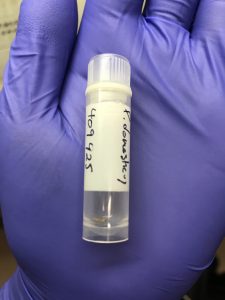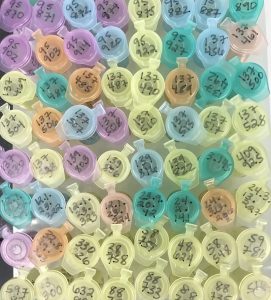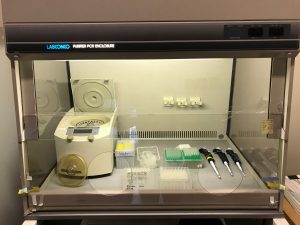You’ve probably heard of introduced species. Perhaps you’ve seen news reports on Burmese pythons in the Florida Everglades or heard about the zebra mussels taking over the Great Lakes. It is well documented that these introduced species can wreak havoc on native ecosystems and threaten biodiversity, and thus billions of dollars are used for management purposes every year. However, they also represent really interesting systems to investigate ecological and evolutionary phenomena. For example, we can ask: how do organisms adapt to novel habitats?
Some of the most successful introduced species are good candidates to ask this question in. One such species is the house sparrow (Passer domesticus). In less than two hundred years, they have colonized most of North and South America, Australia, and many countries across Africa. This has been accomplished by the help of humans bringing them purposefully to new areas, but they have also found ways to sneak in themselves, including catching rides on cargo ships, etc. They are exceptional in their ability to live in diverse habitats. They live in Death Valley, CA where temperatures regularly reach above 110°F and above the Arctic Circle, where winters are unforgiving.
For these reasons, I study house sparrows in their introduced range. I am currently a fourth year Ph.D. Candidate at the University of South Florida in Dr. Lynn Martin’s Lab. I am interested in the molecular mechanisms that may allow house sparrows the flexibility to face these novel environmental conditions and other challenges. Specifically, I focus on a concept our lab calls epigenetic potential. We define epigenetic potential as the capacity for environmentally induced phenotypic plasticity. In simpler terms, this might just mean that house sparrows are better able to use epigenetic mechanisms to alter their traits in a way that allows them to cope with environmental conditions than other species are.

We study epigenetic potential particularly in context of DNA methylation. DNA methylation is an epigenetic mechanism that occurs when a methyl group is added to a cytosine specifically at CpG sites (or cytosines next to guanines in the DNA sequence). This can alter gene expression and subsequent phenotype. Thus, one form of epigenetic potential may be the number of CpG sites a gene has, as it represents a place at which gene expression can be regulated. As an analogy, think of two radios. The first radio has one knob that controls for volume. The second radio has multiple knobs that control for volume, but also bass, treble, balance, etc. So, while both radios are functional, as they produce sound, the radio with more knobs allows for the sound to be tuned more exactly. If we think about the knobs as CpG sites, those sites are places in which DNA methylation can occur or not and thus affect the phenotype (sound in the analogy). The more CpG sites, the more ability for more precise regulation of phenotype.
For this project, we wanted to know whether and how epigenetic potential (number of CpG sites) differs during house sparrow introductions, and how these dynamics may change over time. Fortunately for us, house sparrows have been commonly collected for museum collections giving us access to specimen collected as early as the 1870s to contemporary samples. We were able to collect samples from five independent house sparrow introductions from ~20 years, ~50 years, and ~100 years after their initial introduction. Meaning we will be able to see how epigenetic potential may be playing a role in house sparrow range expansions, understand if these trends are generalizable across populations, and if they change over time. We are taking a targeted approach in this project, investigating promoter and exon regions of genes that we have found to be important in house sparrow range expansions. In total, this project will return over 30,000 base pairs.

We expect that epigenetic potential will be highest at the 20-year time point (closest to time of introduction) for all populations, as the increased plasticity conferred by the high number of CpG sites will be critical for initial survival and establishment. As time goes on and populations become accustom to environmental conditions, this plasticity mediated by epigenetic potential will be less vital as genetic diversity should increase phenotypic variation, and thus we will see a slow decrease of CpG sites over time.

Thanks to g2p2pop laboratory exchange funding, I traveled to Chicago to work with Dr. Dylan Maddox at the Pritzker Laboratory for Molecular Systematics and Evolution at the Field Museum of Natural History. During my first visit in March 2019, Dr. Maddox instructed me on how to extract ancient DNA (aDNA) from house sparrow toe pads (sent to us by American Museum of Natural History, California Academy of Science, Royal Ontario Museum, Museum of Vertebrate Zoology at Berkley, The University of Kansas Natural History Museum, and the Field Museum of Natural History). This DNA extraction must be performed with extreme care, as the age of the DNA increases its likelihood to become contaminated, especially if there is contemporary house sparrow DNA present. For this reason, all extractions were performed in an aDNA facility within a hood that had been decontaminated via UV. In total, I extracted DNA from over 200 house sparrow toe pads. During my second trip in June 2019, we prepared the samples for sequencing on the Illumina MiSeq. This consisted of preparing adapter-ligated libraries and subsequent target enrichment. The fun part (data analysis) begins now.
I would like to thank the g2p2pop RCN for funding, Dr. Maddox and the entire Pritzker laboratory for their assistance and hospitality, the Martin Laboratory for their advice, and the museums mentioned above for their generosity in providing the samples. I can’t wait to see what the data hold!